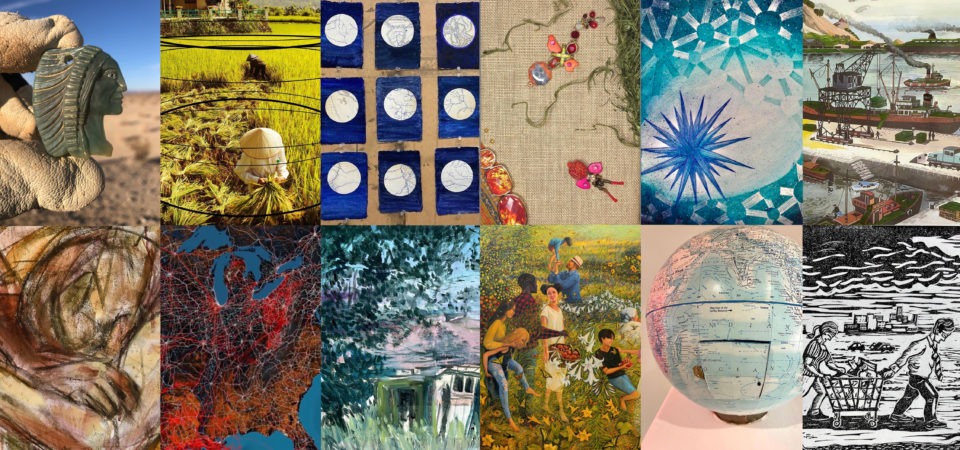– Richard Heinberg
Video Transcript here.
Online Exhibition opened March 13, 2023
Featured Artists
Kirsten Aaboe (US), Jodie Atherton (US), Marie Cameron (US), John Cloake (UK), Alison Lee Cousland (Australia), Yvonne C. Espinoza (US), Dorothy Ries Faison (US), Michele Guieu (US), Colton Hash (Canada), Terri Hughes-Oelrich (US), Deborah Kennedy (US), Nancy D Lane (Australia), Rosalind Lowry (Ireland), Suzette Marie Martin(US), Meredith Nemirov (US), Mona Naess (Norway), Peggy Rose (US), Susan Smith (US), Kim Tanzer (US), Melanie Taylor (US), Marcela Villasenor (US), Gordon Wood (US).
This is the 15th What’s Next for Earth online exhibition based on Think Resilience, a free online course written by Richard Heinberg and produced by Post Carbon Institute.
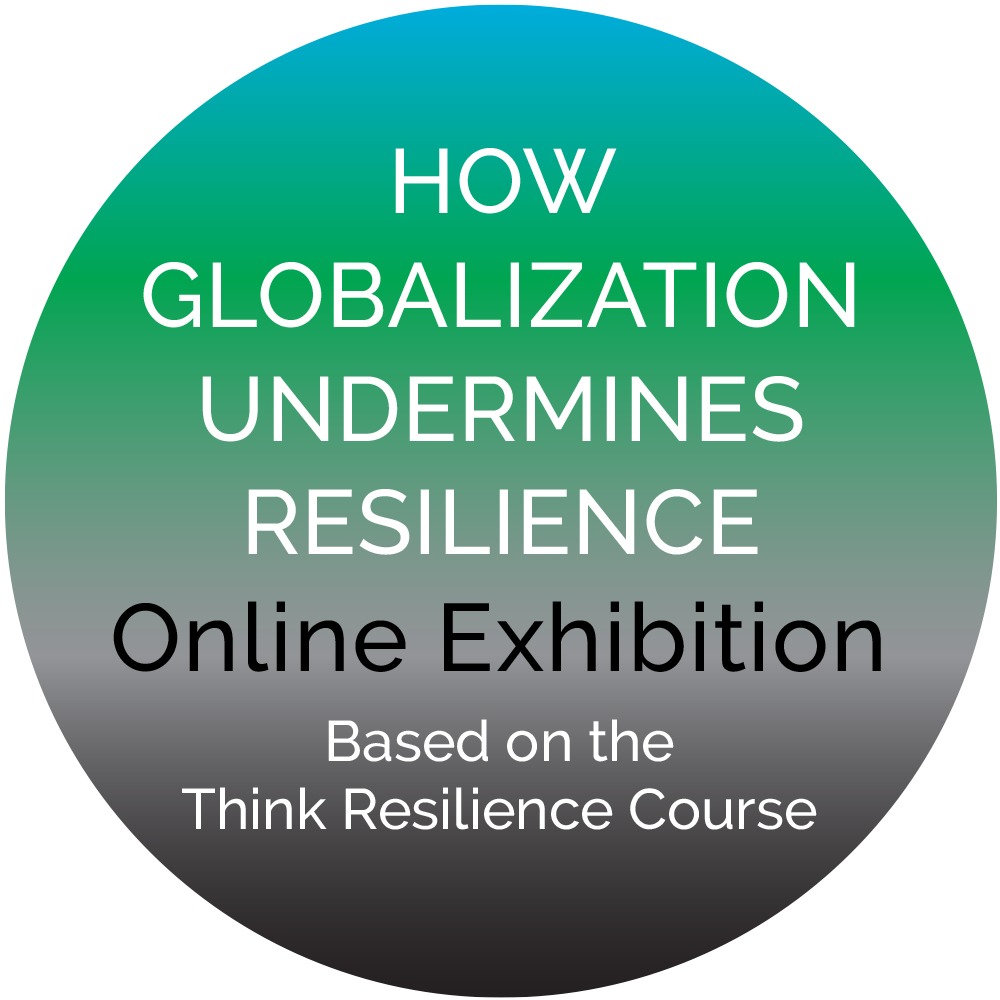 What’s Next for Earth follows the course, one lesson per art call. To respond to this art call, we asked the artists to signup and watch the course. The transcript of the lesson “How Globalization Undermines Resilience” is here. This exhibition opens the fifth chapter of the course: Economy and Society.
What’s Next for Earth follows the course, one lesson per art call. To respond to this art call, we asked the artists to signup and watch the course. The transcript of the lesson “How Globalization Undermines Resilience” is here. This exhibition opens the fifth chapter of the course: Economy and Society.
“Globalization is largely about the relentless pursuit of economic efficiency. And while there are benefits to efficiency (increasing profits, minimizing waste), as an economic strategy it has serious costs to community resilience. Wealthier countries lose jobs for higher-paid wage laborers, as well as the skill base and the infrastructure to produce goods and equipment. The offshoring of manufacturing to poorer nations reduces domestic pollution but increases pollution in the exporting nations (which often have less stringent regulations). Economic inequality increases, both within nations and between nations. And as regions specialize, there is an overall loss of local diversity in jobs.”
Exhibition
Colton Hash
nullTerra
interactive data visualization
2021
nullTerra was created to visualize interconnected resource extraction systems across Canada and the US. Petroleum infrastructure and transportation networks are transnational in nature, spreading across the continent and into the ocean.
Data shown in this video depicts the cumulative footprint of railways, petroleum wells/pipelines as well as forestry operations across the continent. The second section shows offshore petroleum wells, pipelines, and oil tanker traffic on the Gulf Coast.
These industrial systems fragment waterways and forest ecosystems, impacting ecological resilience while also making our society dependent on this infrastructure. Especially evident in the Gulf of Mexico, pipeline corridors through wetlands, oil tanker traffic, and deep water offshore wells all have impacted the integrity of coastal ecosystems and communities.
“Globalization’s anti-resilience, or brittleness, results partly from the diminishing returns of economic efficiency. But it goes deeper. The lengthening of supply chains depends upon the availability of cheap transport, which in turn depends on cheap fuel.” -Richard Heinberg, How Globalization Undermines Resilience, Think Resilience Course.
© 2021 Colton Hash
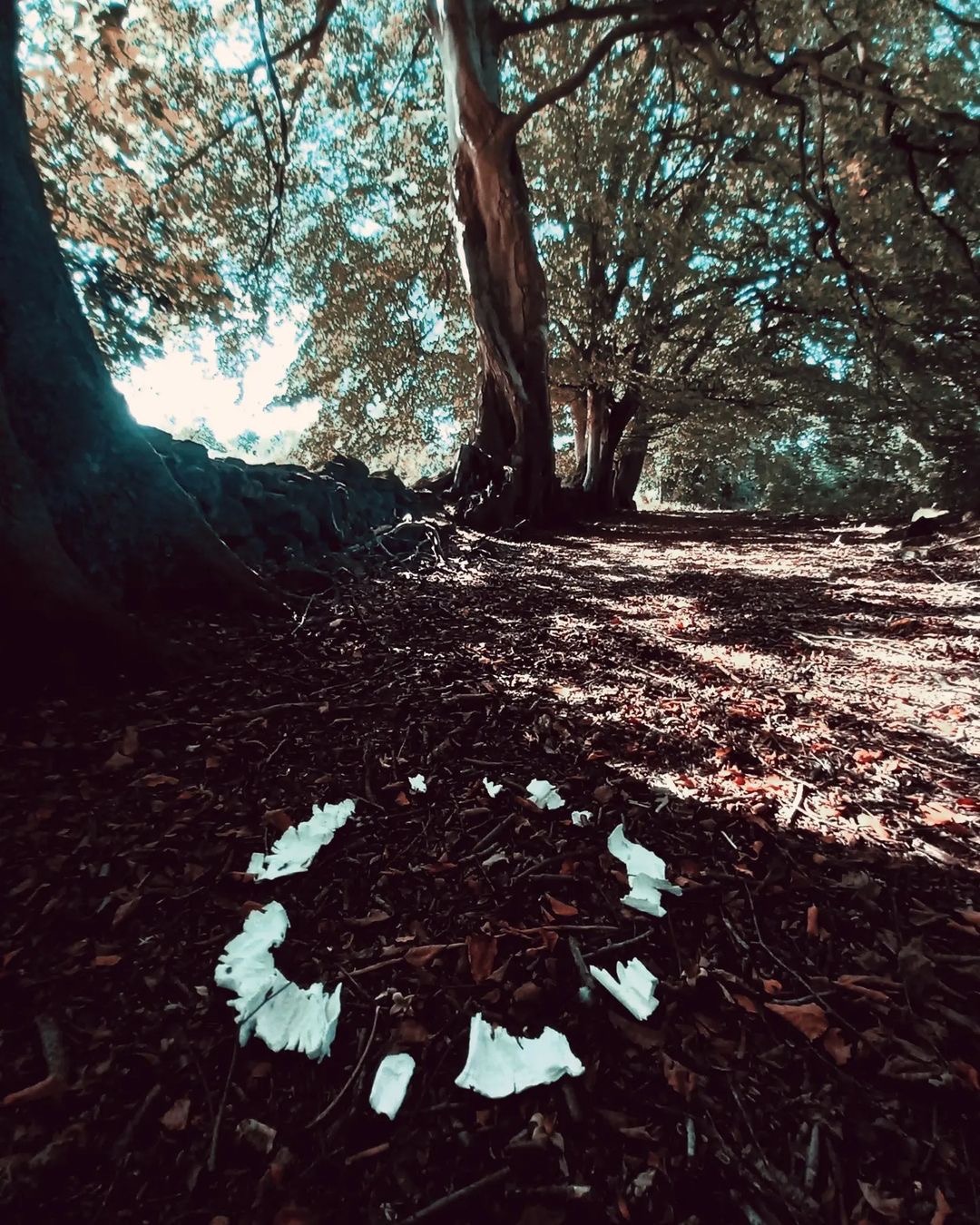
Rosalind Lowry
Broken Circle
Porcelain
2022
Installed on an old unused road in County Antrim, my contribution to What’s Next for Earth for How Globalisation Undermines Resilience. Based on the idea of the circular economy and the concept of designing out waste, and how globalization may be the relentless pursuit of economic efficiency, and the creation of a perfect circle, at the cost of the planet.
© 2023 Rosalind Lowry
Alison Lee Cousland
Grid of Nine
This ‘Grid of Nine’ shows the Southern Pacific Ocean as it reaches the reefs of Shellharbour with its abundance of healthy marine life including oysters in rockpools and cavities of the reef.
Image 2: Grid of 4: Stitched pieces.
Images 3 and 4: Drawing No. 1.
Images 5 and 6: Drawing No. 2.
‘The point is not that all economic efficiency is bad, but that the pendulum has recently swung much too far in favor of globalization and centralization, and a rebalancing is in order.’
Richard Heinberg: Building Community Resilience: ‘How Globalisation Undermines Resilience.’Oyster Reefs: Grid of 9.Ephemeral arrangements using natural materials with central stitched pieces and colored pencil drawings, integrated with photographs taken of the land art project at Sydney’s Middle Harbour: ‘Ecology of Oyster Reefs.’The small textile squares, inspired by marine life, are surrounded by elements from both Sydney’s Middle Harbour and the reefs at Shell Harbour (100 ks south of Sydney.)The colored pencil drawings of oyster shells are on semi-transparent drafting film, so they merge with the background image.The background images: Old worn and empty oyster shells I’d gathered from the murky shoreline of Sydney’s Middle Harbour at Middle Cove, replaced as a ‘trail’ leading up and over part of the reef.
© 2023 Alison Lee Cousland
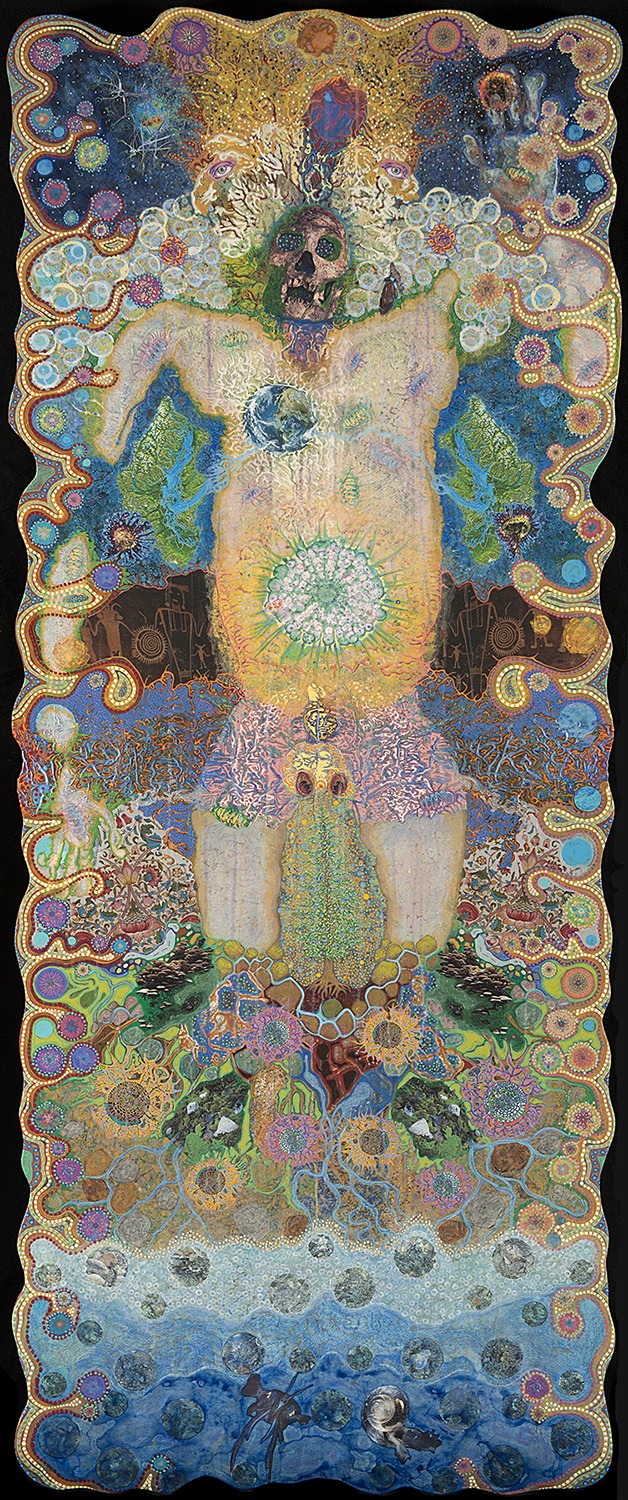
Gordon Wood
Inter-Being, Intra-Imago: A Slow Dilation, Abandoned to Ripeness
Acrylic Collage on Panel
79.5″ x 31.5″
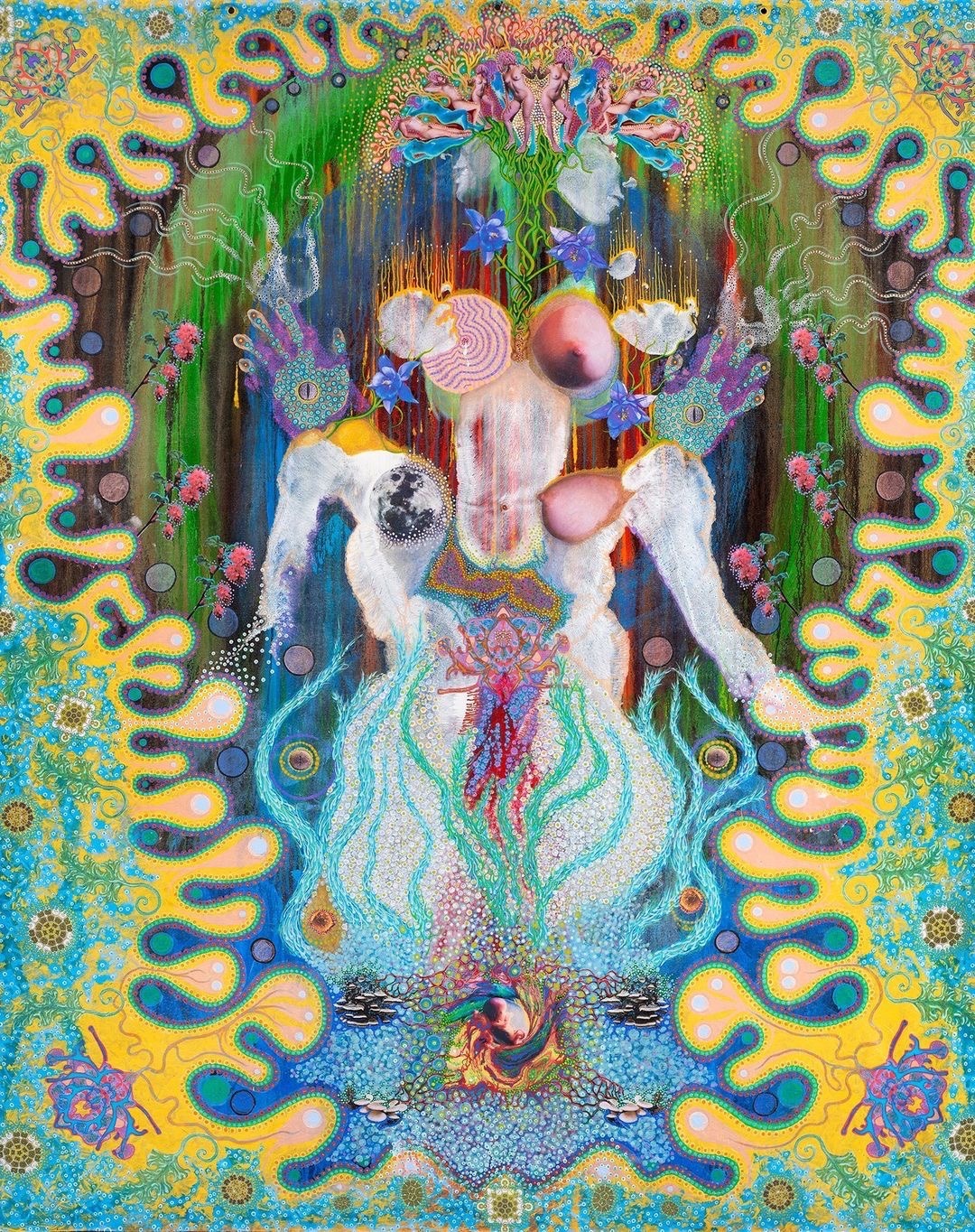
Gordon Wood
Cosmogonic Feminine Reciprocity Embodied
Acrylic Collage on Canvas
72″ x 60″
Redundancy: The state of being not or no longer needed or useful. Globalization is a toxic extension on a planetary level, in all dimensions of life on Earth, human and non-human of the Barbaric Heart. The Barbaric Heart is predominately patriarchal, suppressing the fecundity, generativity and fruitfulness of the feminine. – Gordon Wood “In this time of over-globalization, one alternative—re-localization—offers substantial benefits. It creates local jobs, increases the diversity of local occupations and skill sets, and thereby increases social capital—the richness of the relationships between people who live within a region.” – Richard Heinberg Bioregionalism is (re-)localization, and bioregionalism means following, operating within nature’s true abilities, capacities and boundaries, being respectful of limits in relation to reciprocity as humans, biological beings in the biome. As opposed to culture being dominated and controlled by the market economy, a culture of reciprocity and reconciliation with nature unfolds, nullifying anthropocentric hubris so the biosphere retains its health and balance for all species, humanity and our home, the Commons of Earth. What can evolve is a greater love of life and connection to our “Great Green Land”, vast blue waters, and much more, a renewed concept, consciousness of true wealth, health and happiness. It’s all about living as Interbeings in biophilia. – Gordon Wood And the day came when the risk to remain tight in a bud was more painful than the risk it took to blossom. — Anais Nin
© 2023 Gordon Wood
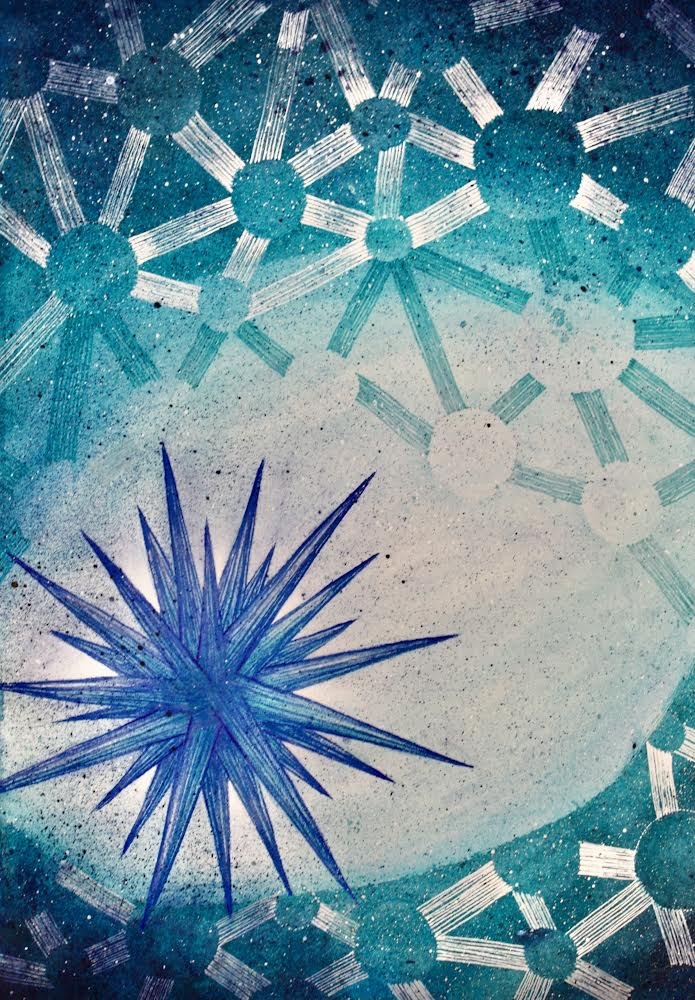
Deborah Kennedy
Project Nexus
ink drawing on eco-paper from India
22”x30”
This piece utilizes data visualization techniques. This is a way to present information and data in an image used by industry and policymakers. In this drawing, the spiky form suggests the aggressive growth of a potentially destructive technology supplanting the tenuous social connections surrounding it.
© 2023 Deborah Kennedy
Kim Tanzer
Swerves Off the Grid
Oil on canvas
12” x 12”
These small paintings are part of an ongoing project called “Watershed Anecdotes” which pairs expressive mappings with abstracted landscape paintings. In each I seek to connect an abstract, Cartesian logic with lived experience.
Each painting reveals the interplay between a road or property boundary—by happenstance located on a subdivision of the Jeffersonian grid–and a swerve, where local features intervene.
The Jeffersonian grid is formally the Public Land Survey System. It was initiated by Thomas Jefferson to efficiently subdivide lands beyond the original 13 colonies and it expanded west as the United States proceeded to conquer the continent. Many roadways and land subdivisions, including every straight line in these paintings, are part of the totalizing logic of the Jeffersonian grid.
Meanwhile, the elements I characterize here as “swerves”—a lake, a river, an old footpath with its totemic tree, and two springs flowing to different watersheds—resist the logic of the grid. These topographies explain, in part, why the terrain portrayed in these paintings has been continuously inhabited for several thousand years. They offer hints toward a more resilient, localized future.
Spatial grids are efficient and apparently egalitarian. Yet by ignoring local circumstances, they reinforce a logic of universality at the expense of the specific and unique. One result is what author Richard Heinberg describes as “globalization’s anti-resilience, or brittleness.” As Heinberg argues, life on our Earth requires “an appropriate balance between centralization and decentralization, and between economic efficiency on one hand, and redundancies that foster resilience on the other.”
I offer this series of paintings as both an example of the spatial logic of capitalism, and a metaphor for its antidote.
© 2023 Kim Tanzer
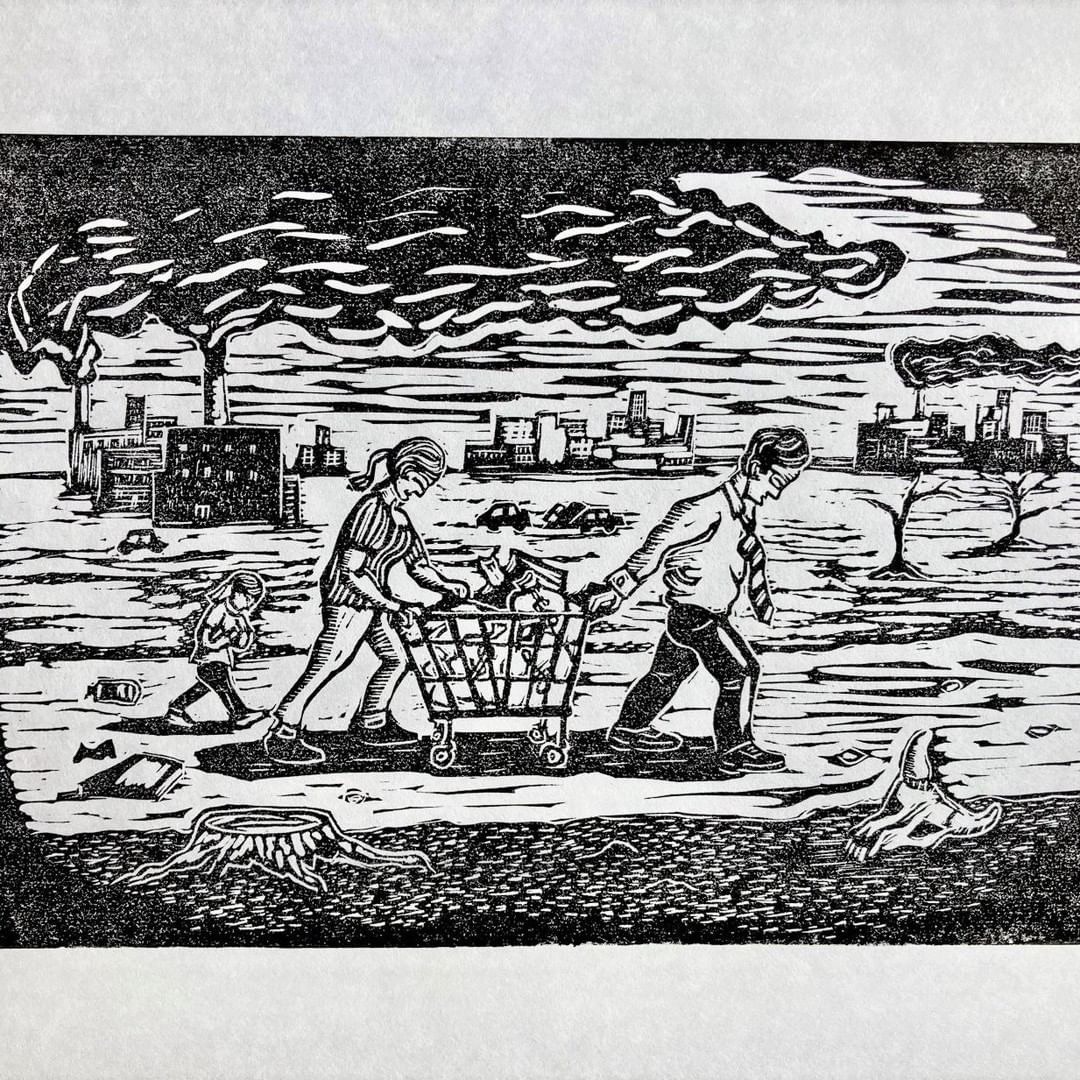
John Cloake
Eden Lost
Linocut
30x20cm
Limited Edition of 30 printed on Japanese Hosho paper
It is well known that an artist loses control over the interpretation of the piece because viewers bring their own readings but this time, it is me bringing new readings! My print was originally created as part of my “Climate Crisis” series. I was driven by a growing sense of anger and frustration that our obsession with “growth” and “profit” was leading to climate destruction and a wasteland society. The “Think Resilience” discussion has provided an interesting new lens in demonstrating the role of over-globalization in this process and why the apparent short-term benefits become dangers over time.
Here is an extract from Richard Heinberg’s talk: “Globalization is largely about the relentless pursuit of economic efficiency. And while there are benefits to efficiency (increasing profits, minimizing waste), as an economic strategy it has serious costs to community resilience. Wealthier countries lose jobs for higher-paid wage laborers, as well as the skill base and the infrastructure to produce goods and equipment. The offshoring of manufacturing to poorer nations reduces domestic pollution but increases pollution in the exporting nations (which often have less stringent regulations). Economic inequality increases, both within nations and between nations. And as regions specialize, there is an overall loss of local diversity in jobs.”
But as Heinberg points out “The point is not that all economic efficiency is bad, but that the pendulum has recently swung much too far in favor of globalization and centralization, and a rebalancing is in order”. Looking forward to seeing his suggestions for achieving that in the next chapter!
© 2023 John Cloake
Jodie Atherton
The Damn Dam
A 1996 world globe and other outdated and seemingly unwanted materials.
That was the year I learned about the Glen Canyon Dam on my first trip down The Grand.
I’ve since watched water evaporate off Lake Powell ever since. Witnessing our climate changing. Wondering.
Why?
Why are green lawns in the desert even an option.
When?
Now it’s all over the news.
I watch the lack of attention to water use in the west closer than ever now. Sigh.
This dam has a limited shelf life. What’s the bottom line? And at what cost? And to who? And what?
© 2023 Jodie Atherton
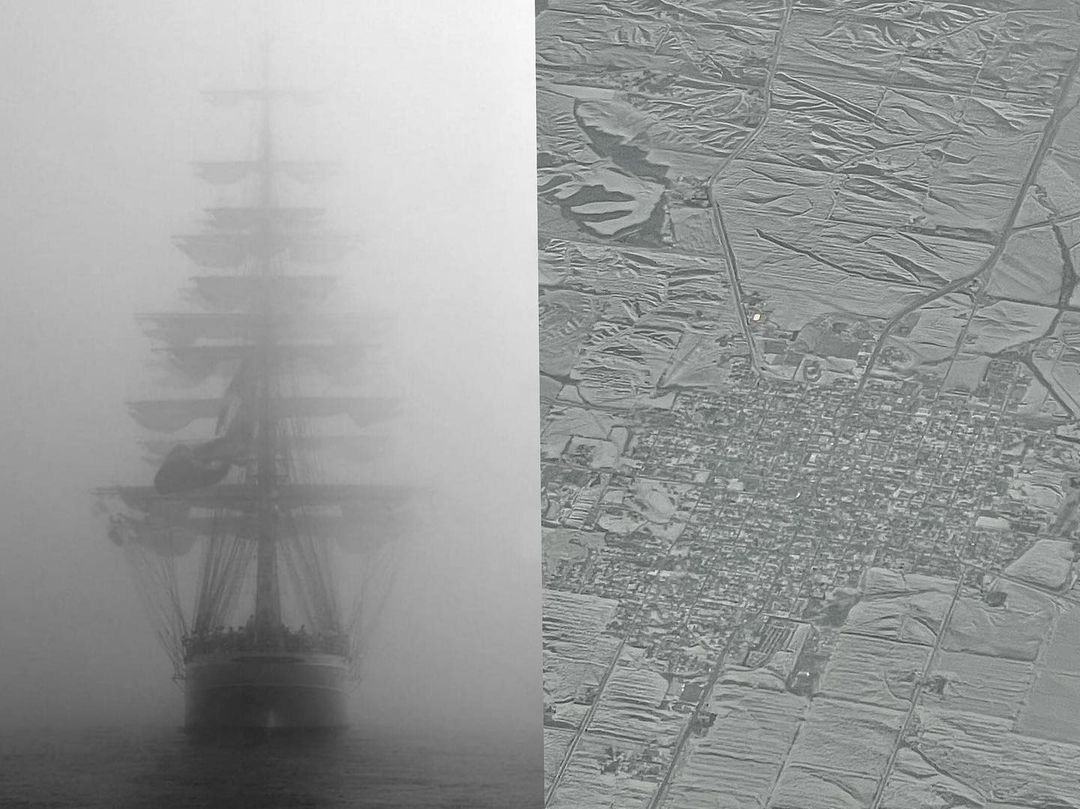
Kirsten Aaboe
Horizontal and Vertical / Contained And Dispersed
Digital photo mashup
Left: an online image of a ghost ship from a travel ad on Instagram. The photo was originally taken in 1900.
Right: cityscape photographed by me in January 2023 from 35k feet up in the midwestern United States
The strong trend toward globalization that has characterized the world economy since the 1970s has had a lot to do with three technological developments: container ships, computerized monitoring of inventories, and global satellite communications. But it also resulted from (1) the relentless pursuit of profits and efficiency, (2) increasing international investment (often facilitated by the World Bank or the International Monetary Fund), (3) the lifting of trade restrictions and protective tariffs, (4) the expansion of trade agreements through the efforts of the World Trade Organization, and (5) the increased financialization of the economy and pressures on corporations to ensure quarterly profits.”
“In this time of over-globalization, one alternative—re-localization—offers substantial benefits. It creates local jobs, increases the diversity of local occupations and skill sets, and thereby increases social capital—the richness of the relationships between people who live within a region. In the next video, #17, we’ll look at how re-localization can contribute to regional economic development and build community resilience.”
© 2023 Kirsten Aaboe
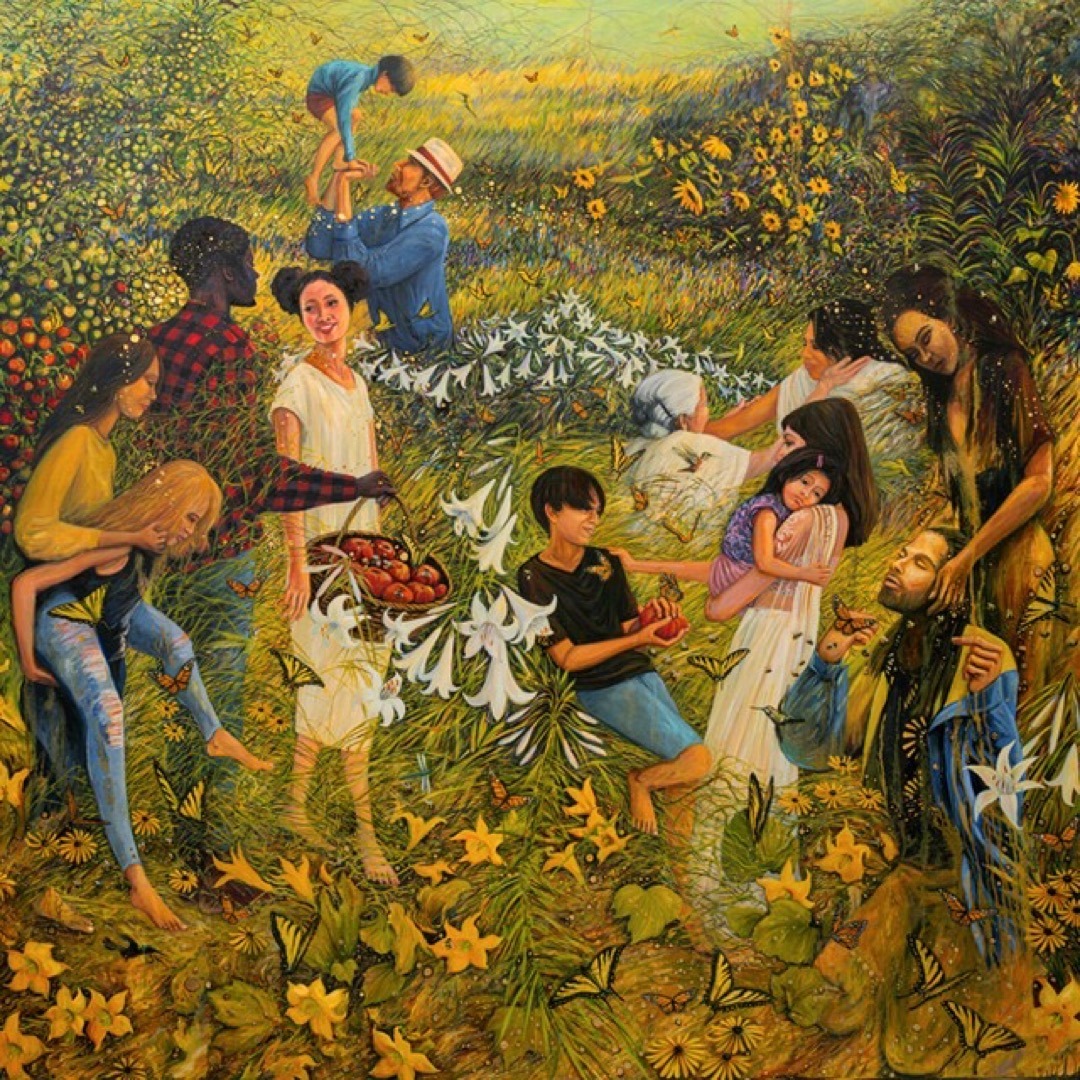
Marie Cameron
We Are Stardust
Gold leaf and oil on canvas
58.5″ x 58.5″
In considering “How Globalization Undermines Resilience” and the question of building community resistance (based on the Think Resilience course by the Post Carbon Institute), I thought of my painting “We Are Stardust” which I created in 2020 in a time of strife that was environmental, social, political, economic and framed in the context of an unprecedented global pandemic.
In this piece, inspired by Joni Mitchell’s song, Woodstock, I tried to convey what I imagined a healthy community could look like in terms of a flourishing garden. Here there is balance and wellness precisely because of the rich diversity and symbiotic relationships that benefit all and make for a fertile and functioning ecosystem where everyone benefits instead of just a few.
“In this time of over-globalization, one alternative—re-localization—offers substantial benefits. It creates local jobs, increases the diversity of local occupations and skill sets, and thereby increases social capital—the richness of the relationships between people who live within a region.”
© 2020 Marie Cameron
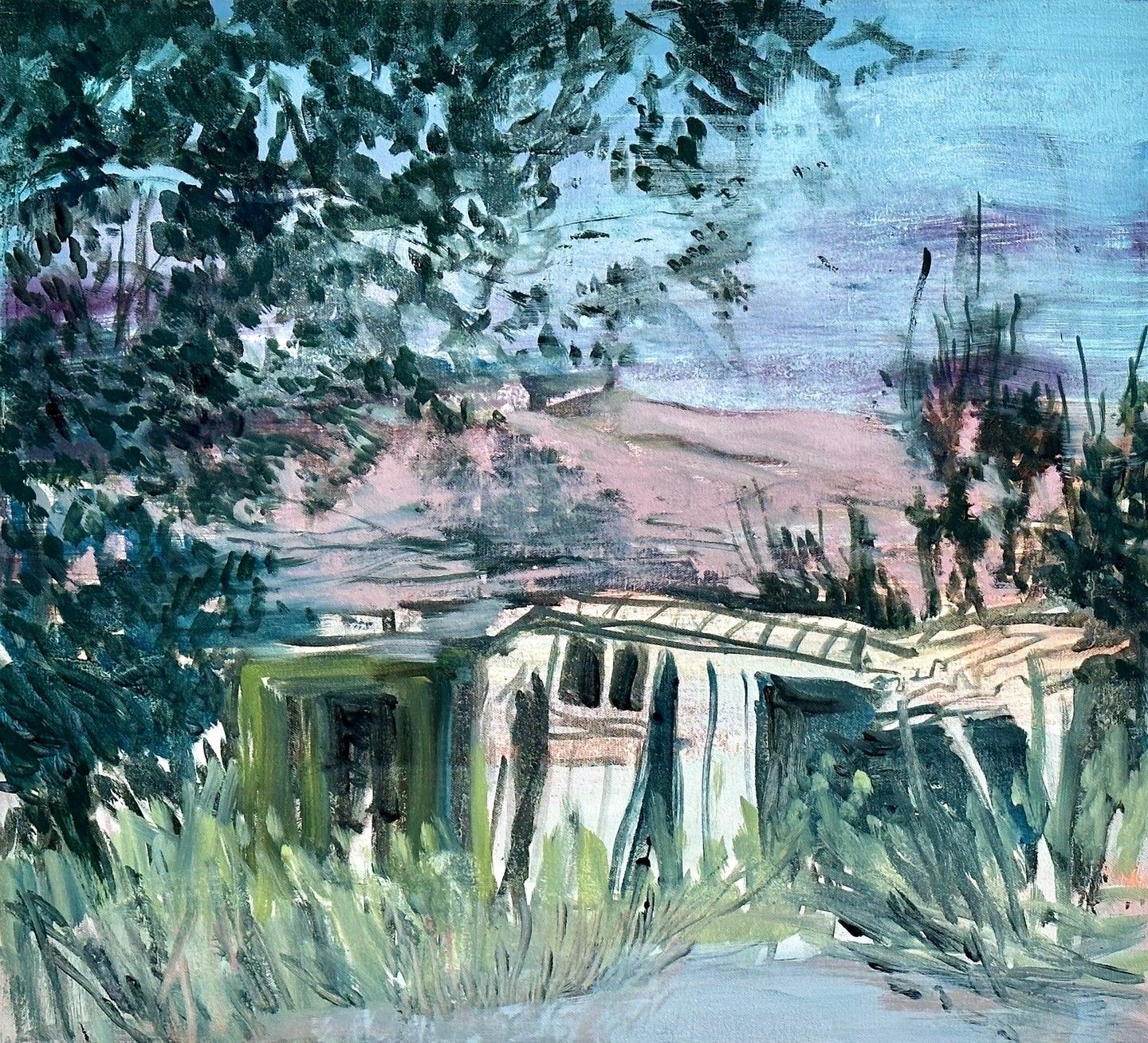
Melanie Taylor
Derelict Farmstead
Oil on canvas
20”x22”
This painting depicts a derelict farmstead in the Tijuana River Valley that I have observed slowly disintegrating and being overcome by the natural surroundings, an abandoned relic of independent farming. Farmers left the region owing to a combination of globalization and flooding that brought with it contaminated water, silt and refuse, an issue that continues in the region today. The ruins of old farmsteads and remnants of agricultural fields, now returning to their natural habitat, remain. “The pendulum has recently swung much too far in favor of globalization and centralization, and a rebalancing is in order.”
© 2023 Melanie Taylor
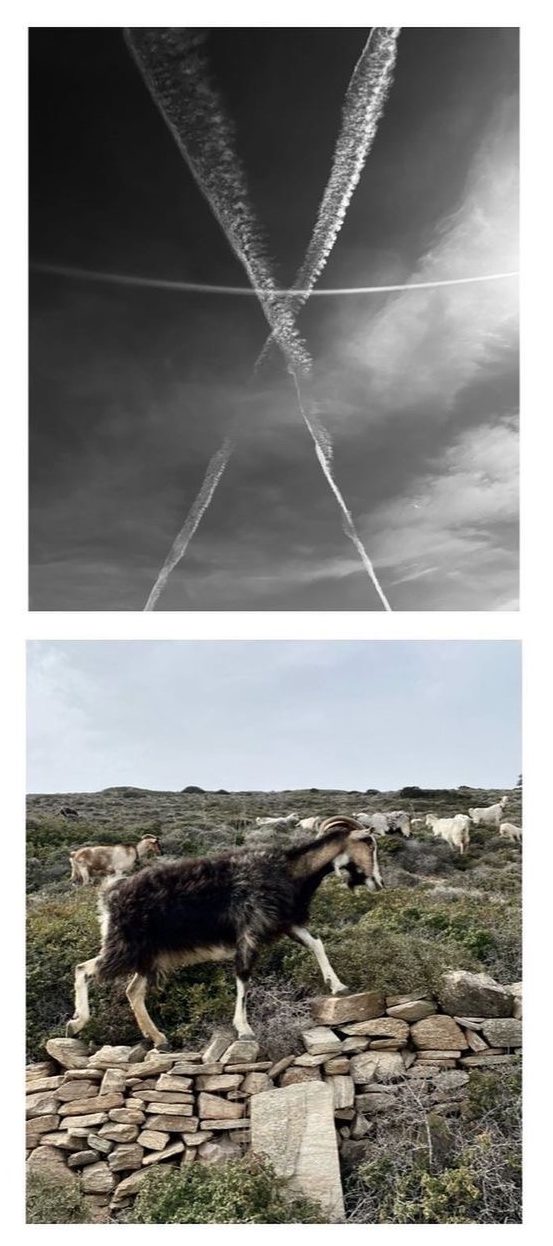
Mona Naess
Planes crossing the sky – A local goat on a small greek island.
Two photographs
March 2023
One day when I was out walking in the mountains, I met a local shepherd. He was so proud of his goats; I’m sure he makes the best local Greek cheese in the world. I looked up in the sky and planes were crisscrossing, and I thought about the huge cheese selections in the shops owerflowing with cheese from all corners of the world..
“[…]we should be localizing as much manufacturing and food production as we can. It creates local jobs, increases the diversity of local occupations and skill sets, and thereby increases social capital- the richness of the relationships between people who live within a region.” Richard Heinberg, How Globalization Undermines Resilience, Think Resilience Course.
© 2023 Mona Naess
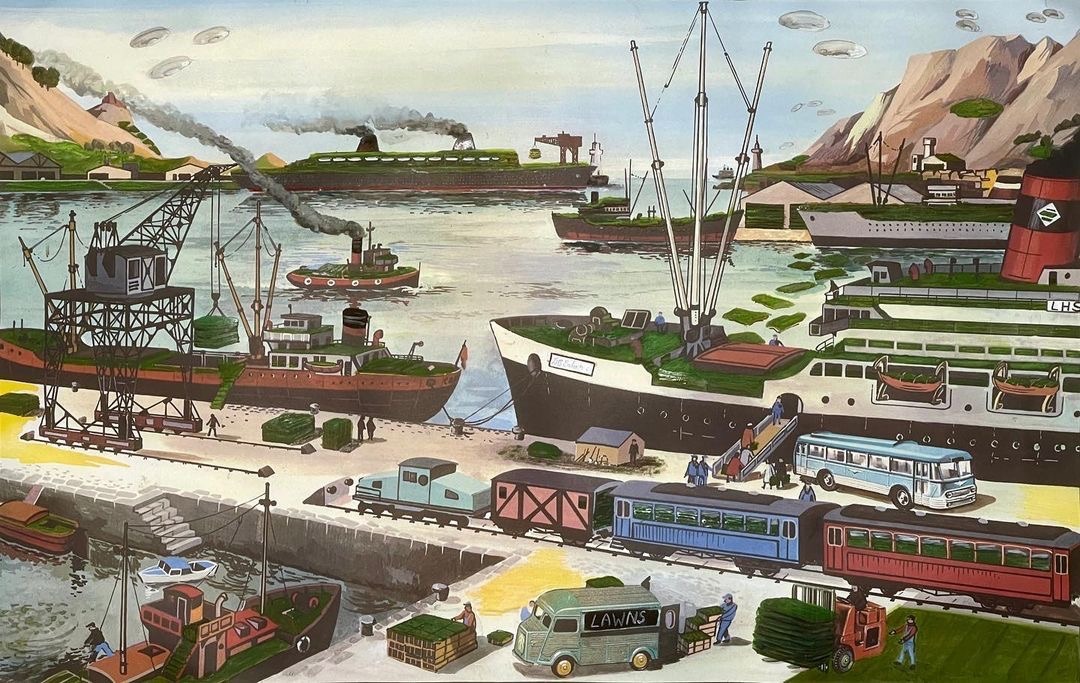
Dorothy Ries Faison
Lawnboats at Le Port
Altered French school poster: watercolor, water-soluble crayons and ink on an educational poster (Ogé-Hachette, Bonmati & Michel)
55 x 59 in 140 x 150 cm
2023
This vintage school poster has been altered through paint to focus on the exploitation of an aesthetic monoculture –the lawn– in lieu of forests, biodiversity habitats and food production. Not trivial, lawns are the largest “crop” in the US. Specialization reduces resilience to internal and external shocks, climate being just one. Lawns are polluters and are wastelands for biodiversity.
© 2023 Dorothy Ries Faison
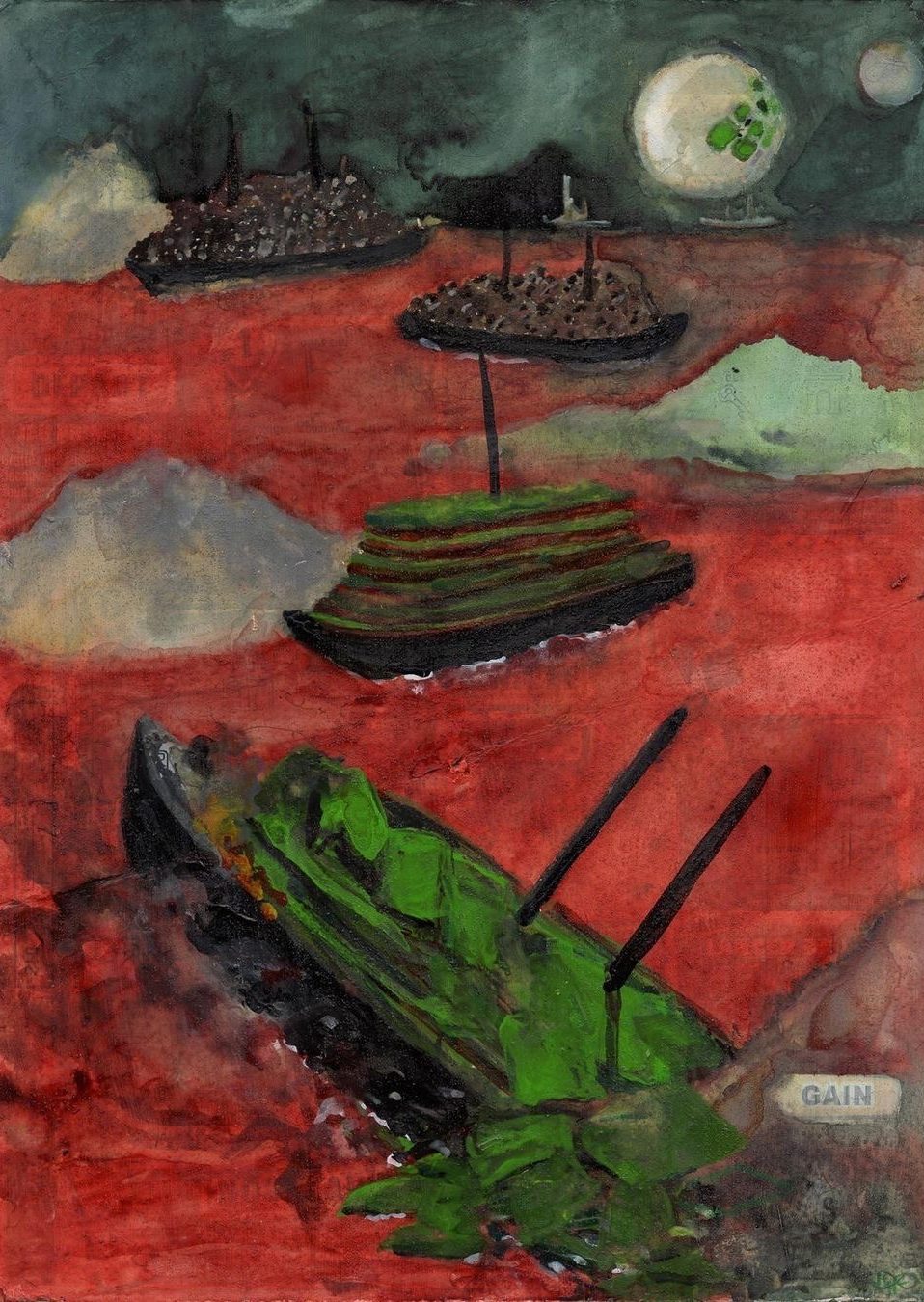
Dorothy Ries Faison
Lawnboats and the Globalization of Lawns
Watercolor and water soluble pencil on found folded unlucky lottery card
8 x 5.8 in – 20 x 15 cm
2023
The allegorical lawnboat trade reconstructs the history of the Hawaiian sandalwood trade: trading lawns for sandalwood. An endemic species for a non-consumable alien plant.
This undermined the resilience of the population by forcing farmers and fishers to collect sandalwood, which led to starvation and death. The planting of lawns over the next 200 years has been an ecological disaster, resilience just one of many. The moon is a comment on the absurdity of planting golf course lawns.
The painting is on a folded and weathered unlucky lottery card found on a daily walk to my studio in Southwest France. Tossed cards are the unlucky ones. Probabilities make millions of these tickets unlucky. Ironically this card is for supporting the “patrimoine” of France.
© 2023 Dorothy Ries Faison
Suzette Marie Martin
Dryad of Post-Industrial Collapse (New England)
Acrylic paint, matte latex house paint, vine charcoal, graphite, and colored pencil on canvas.
63″ H x 84″ W.
2021
The figure is slightly larger than life-size!
The title references not only the gesture of the figure, collapsed in sparse second-growth woodlands, but the collapsed economy of a region whose former industrial base contributed to the escalation of greenhouse gas emissions and left behind polluted mill towns, widespread poverty, and addiction crises when manufacturing left the region. From the course:
“Efficiencies of scale also produce systemic inefficiencies elsewhere in the system—the loss of well-paying jobs, for example, that provide people with incomes that enable them to buy products. At first, those inefficiencies and costs are minimal in comparison with the immediate payoff in terms of lower prices and higher profits. Gradually, however, as the strategy is implemented, costs continue to increase while payoffs decline.”This is from my series “Dryads of the Anthropocene” where I use ancient nature deities as proxies for the collapsing ecosystems they traditionally embodied and protected. In the detail, you can see molecular symbols of the major industrial greenhouse gases fueling the climate crisis.
© 2021 Suzette Marie Martin
Yvonne C. Espinoza
When We Are FAmiy 1 & 2
Each piece: repurposed costume jewelry, textile, dried moss on burlap.
10” x 10”
“Reducing economic diversity may be efficient, but it also reduces resilience.”
“….as regions specialize, there is an overall loss of local diversity in jobs.” -Richard Heinberg
Do our avocados, T-shirts, mobile phones, and even sneakers come at the expense of another’s safety, freedom, and life?
Our parents came to the US as a way to partake of the “American Dream”. This was a vision spread throughout our world.
Family, health, security, freedom, and the promise of success are possible.
Hope for a beautiful outcome is still at the edges of every act and word we release.
We pick up after those who have forgotten that freedom, in the long run, is about working together. Living together is about experiencing humanity in all its diversity. It is a rallying cry to move beyond societal mono-culture.
In the biological world, groups of organisms create change. Each organism, some slightly different, provides the ability to provide the evolutionary adaptation to move forward.
In my work, an array of old and new, synthetic and natural, collected here and manufactured far away, are used to piece together “living” beings and communities.
© 2023 Yvonne C. Espinoza
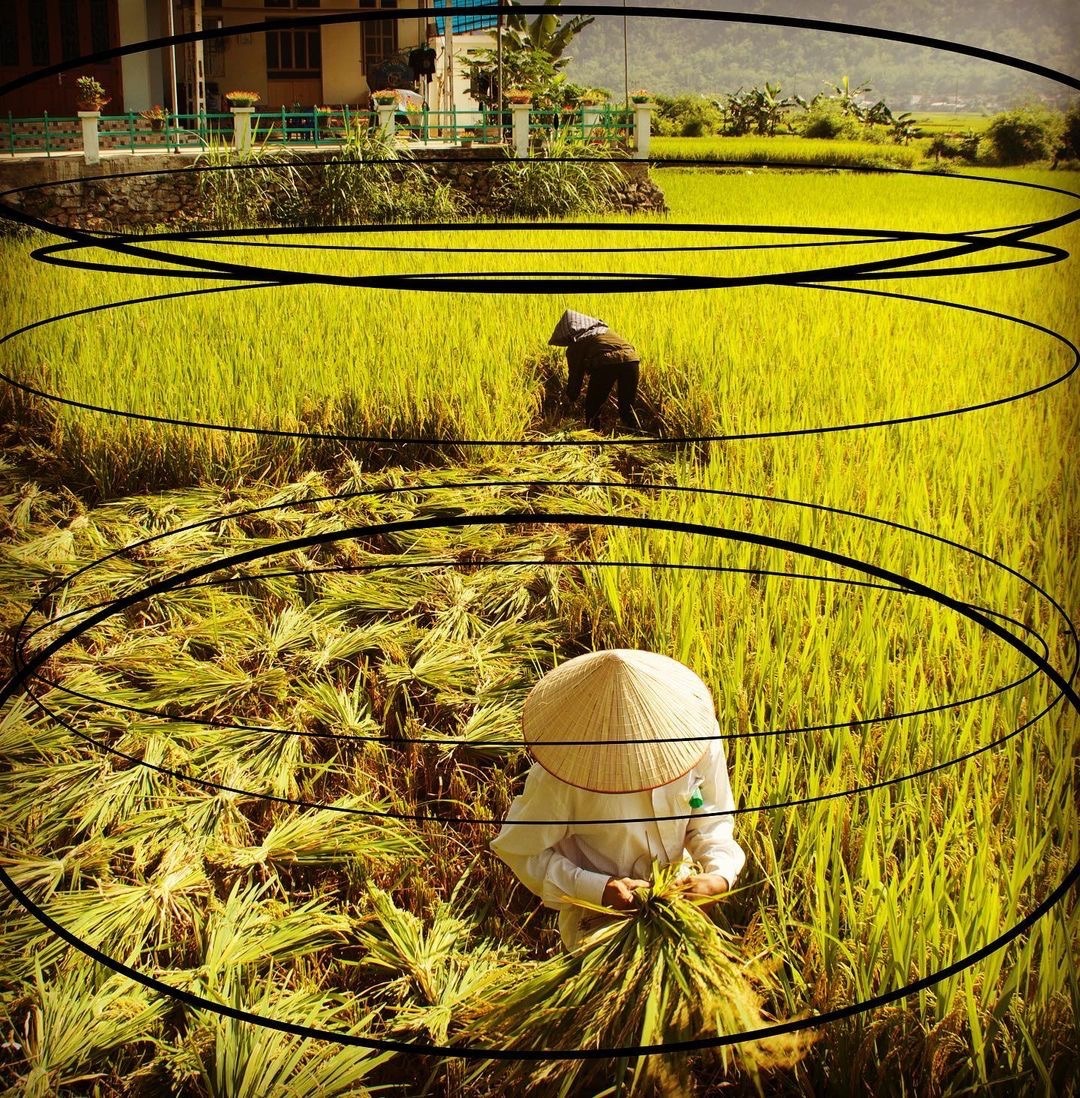
Marcela Villaseñor
La Cosecha – The Harvest
Fotografía digital
2019-2023
Let’s try to create a circle of consumers of local products (market on wheels), (Tianguis), (farm markets). Let’s try to avoid the globalization of products to benefit the wages of workers and create resilience against globalization. We can start little by little consuming native merchandise.
We should live in harmony with the land, return to the philosophy of indigenous peoples, consuming what we produce in order to become an independent nation (Mexican, American, Vietnamese or French).
Tratemos de crear un circulo de consumidores de productos locales, (mercado sobre ruedas), (Tianguis), (farm markets), tratemos de evitar la globalización de los productos para beneficiar a los salarios de los trabajadores y crear una resiliencia contra la globalization . Podemos comenzar poco a poco consumiendo mercancía autóctona.
Deberíamos de vivir en armonía con la tierra ,regresar a la filosofía de los pueblos indigenas ,consumiendo lo que producimos , para poder llegar ha ser una nación independiente (mexicana, americana, vietnamita o francesa) .
“Wealthier countries lose jobs for higher-paid wage laborers, as well as the skill base and the infrastructure to produce goods and equipment. The offshoring of manufacturing to poorer nations reduces domestic pollution but increases pollution in the exporting nations “
Richard Heinberg
“Los países más ricos pierden puestos de trabajo para los trabajadores mejor pagados, así como la base de habilidades y la infraestructura para producir bienes y equipos. La deslocalización de la fabricación a países más pobres reduce la contaminación interna pero aumenta la contaminación en los países exportadores”
Richard Heinberg
© 2023 Marcela Villaseñor
Meredith Nemirov
River Earths
Watercolor gouache
historic topo map on handmade paper
4″ x 6″
View Gallery
As stated in lesson 16 of the Think Resilience course from the Post Carbon Institute, “Globalization is the relentless pursuit of economic efficiency which has serious costs to community resilience.” The focus of my recent work has been rivers. Natural rivers have a high level of resiliency, but in the 20th century, nations, in their effort to provide more energy, more efficiently harnessed the power of the rivers by building dams to further industrialization. This is a clear example of how the pursuit of more energy has had serious costs to our nation’s, and the world’s, rivers and the communities that live along their banks.
© 2023 Meredith Nemirov
Nancy D Lane
Globalized Overreach
found object assemblage sculpture created from pieces of metal mounted on rubber and linoleum, all found on the streets of Melbourne.
My conceptualization of globalization, based on the Think Resilience online course from Post Carbon Institute, shows the pursuit of efficiency (machinery cogs and wheels), workers treated as machinery components (the three ‘heads’), and reliance on international transport (swirling lines on the lino).
How best to suggest that over-globalization is detrimental to society and the Earth? I’ve tried four versions: a half frame pointing upwards and leftwards to a void; a rocket-shaped frame hurtling towards emptiness left and right; a green screen, implying the limits to Earth’s resources; and the blue, oddly shaped framing suggesting the ‘stumbling blocks’ of globalization. Which makes the point best for you?
© 2023 Nancy D Lane
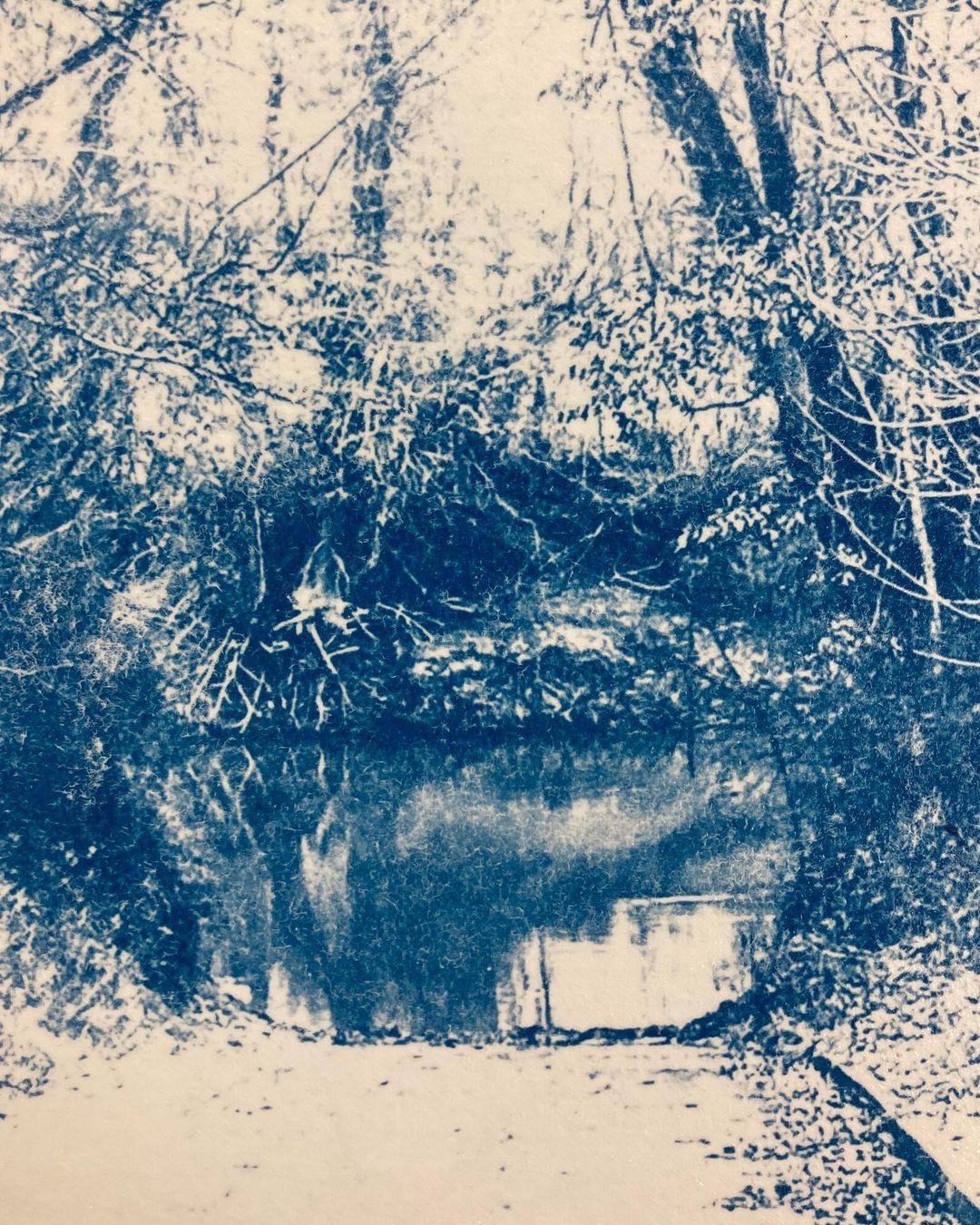
Susan Smith
Oostanaula River, Calhoun, Georgia
Cyanotype with river water
December 2022
Part of a series created as I travel the country researching sites identified as having significant levels of industrial soil and water contamination from PFAS.
This location is downstream from the world’s center for flooring and carpet manufacturing. The PFAS levels and effects are some of highest in nation. I bear witness, collect these soils and waters, and create art I consider “evidence.”
I connect this work to the course’s emphasis on the effects of flow of capital and creation of insatiable consumer appetite.
© 2023 Susan Smith
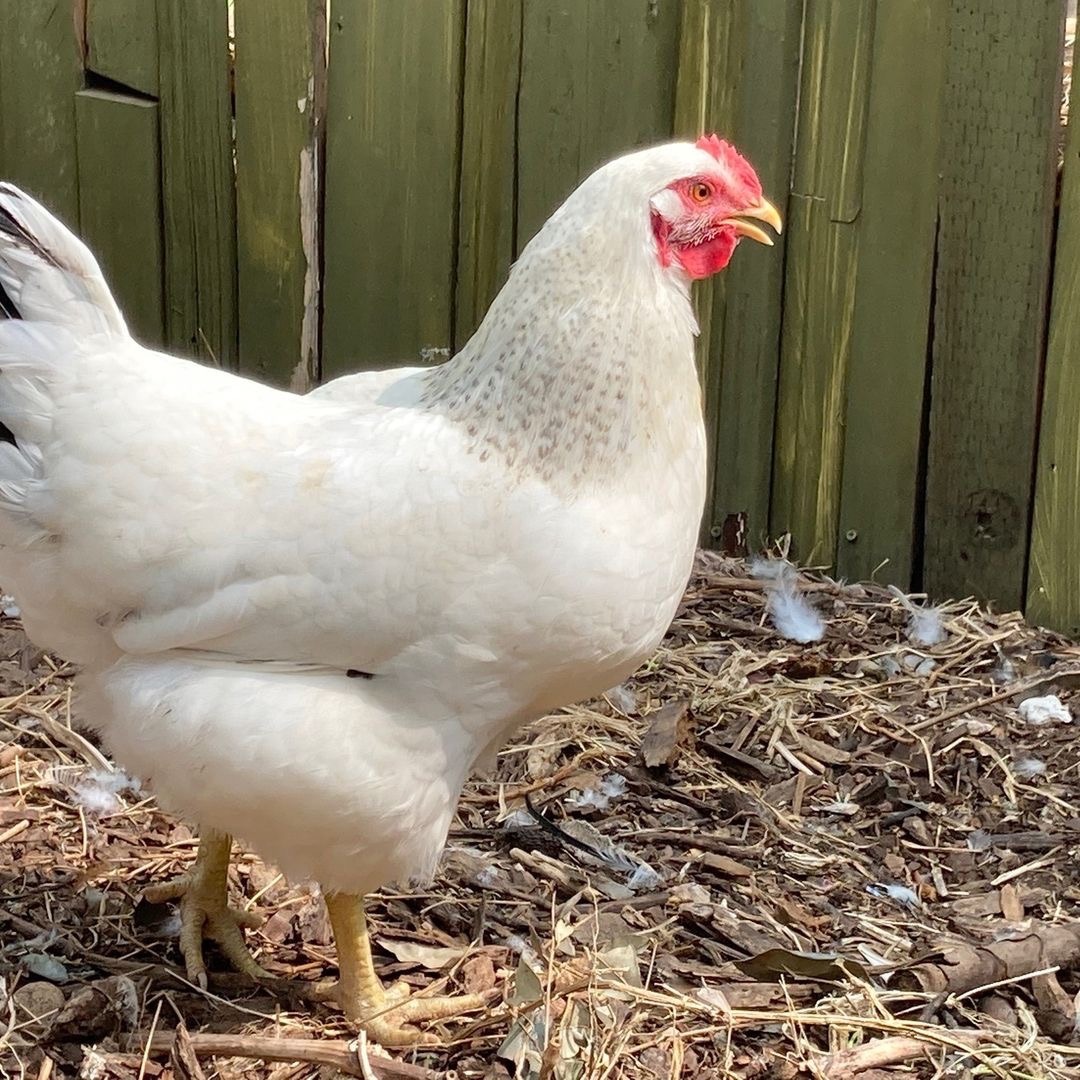
Terri Hughes-Oelrich
My Chickens
Photograph
2023
For the “What’s Next For Earth” call, I thought about my chickens. It’s cheaper to buy organic free-range eggs in the store than to raise chickens. That’s economic efficiency. But currently, when a shortage of eggs due to bird flu happens, my chickens start laying more as the days get longer. I can walk in the backyard and find the latest spot where they lay their eggs. On the other hand, balance is key. Growing cocoa trees and making chocolate will not work so easily in my backyard. And, I am so lucky to even have a backyard to do this.
“Economic efficiency tends to lead to more specialization: individuals specialize according to their skills, and regions specialize according to their relative abundance of resources (such as minerals, water, or energy). Efficiency also leads to economic stratification, both within regions (because some professions are more highly rewarded than others) and across regions (as manufacturing moves to places with lower labor costs).”
Richard Heinberg, “How globalization undermines resilience“, from the Think Resilience course.
© 2023 Terri Hughes-Oelrich
Michele Guieu
Made in Hongkong
Two photographsObject found in the Mojave desert during my artist residency at Desert Dairy in Twentynine Palms, California, in February 2023.
When I collected the rusted cans today for my piece, I found a few other interesting objects, like this small plastic pendant made in Hongkong. A sobering tale about globalization, fossil fuel used to make useless plastic objects and transport them worldwide, the commodification of Native American imagery, and pollution of a fragile ecosystem in the Mojave desert in California.
If there is something the Think Resilience course helped me understand is that thinking in systems makes you see everything differently, through a different lens. Globalization is indeed linked to the use of fossil fuels. Without the fleets of thousands of cargo ships roaming the world, there would be no access to cheap stuff. If we want to slow down on fossil fuels, the way we trade will also change. Ultimately, we always go back to the fact that we have to change this globalized system that transforms nature into waste for short-term profit. There are other ways. We need to change the stories.
© 2023 Michele Guieu
Michele Guieu
Everything, anytime (it ends up in waste)
Ephemeral composition with small blue wooden scraps and found objects fragments made of glass, various plastics, wood, and metal
Objects found in an unauthorized dumping site in the Mojave Desert, California.
This piece was made during my artist residency at Desert Dairy, Twentynine Palms, in February 2023.
View Gallery
Globalization allows us to buy pretty much anything at any time. It sounds normal, right? Goods come from around the world, all year round through an endless fleet of cargo ships, trains, and trucks. More and more goods (that we do not necessarily need) mean more extraction, and more use of fossil fuel for every step (extraction, fabrication, transportation). We need to put a brake on the use of fossil fuel starting immediately if we want a chance to keep a habitable planet. So the idea that everything is always available may not last much longer.
“Globalization’s anti-resilience, or brittleness, results partly from the diminishing returns of economic efficiency. But it goes deeper. The lengthening of supply chains depends upon the availability of cheap transport, which in turn depends on cheap fuel. In video 4 we discussed the inevitable problem of oil depletion. This, by itself, poses a serious limit to further globalization, and eventually to the maintenance of current supply chains. Further, minimizing climate change requires that we reduce oil consumption dramatically and quickly. There are ways to substitute for oil in transport—electric cars, sails for ships, or fuels made using renewable-based electricity as an energy source. But these are incomplete substitutes. As we discussed in video #2, it’s unlikely that the energy economy of the future will be able to support transportation at current levels. That means we should be localizing as much manufacturing and food production as we can.”
© 2023 Michele Guieu
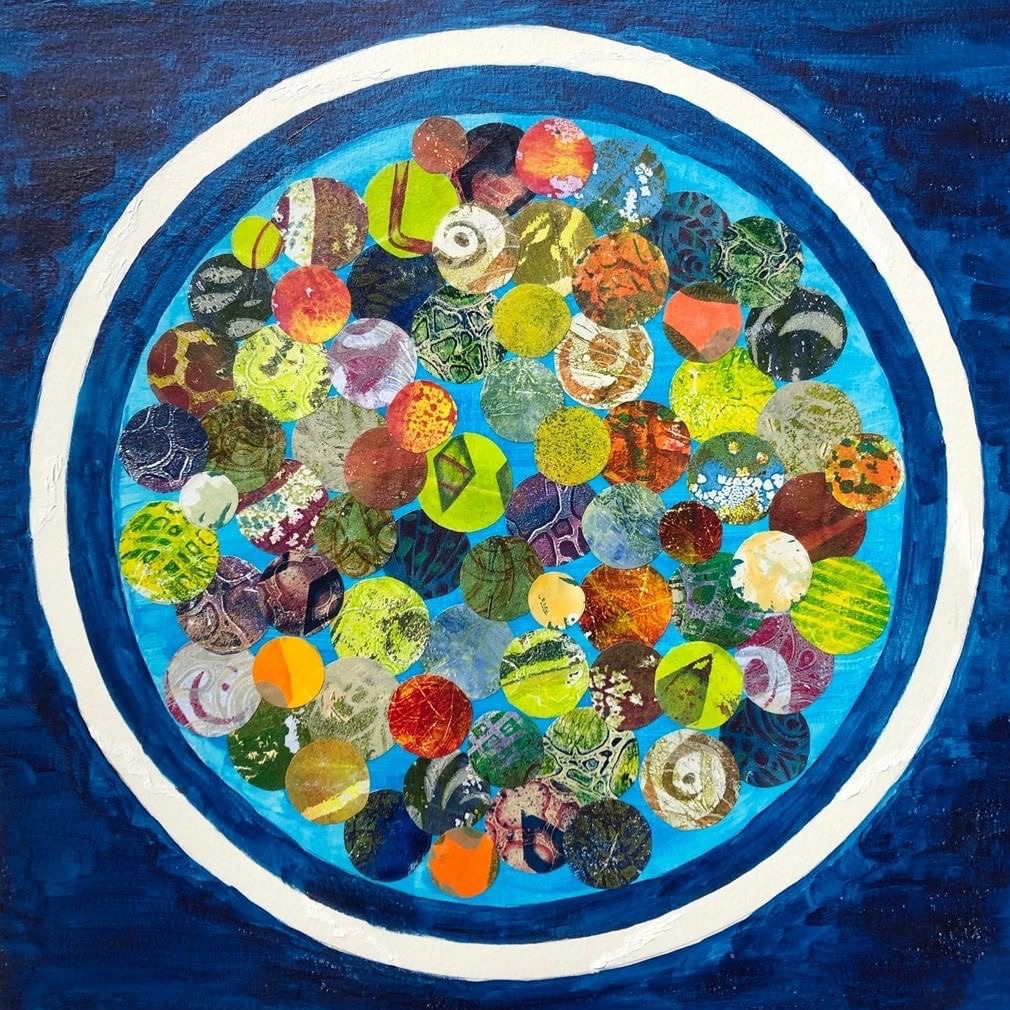
Peggy Rose
The Edge Ratio
Mixed media
12″ x 12″
The Edge Ratio: the larger the circle, the smaller its edge relative to the area. More edge equals more diversity, more productivity, and greater stability.
Richard Heinberg: “[…] globalization reaches a point of diminishing returns” […]”encourages redundancy.”
© 2023 Peggy Rose
This exhibition is based on Think Resilience, Post Carbon Institute’s free online course. To respond to the art call, we asked the artists to signup and to watch the course, one lesson/video at a time. Each video is approximately 12 minutes long.
[Lesson 1: Introduction to the course]
CHAPTER 1: Our Converging Crises
- Lesson 2 – Energy
- Lesson 3 – Population and Consumption
- Lesson 4 – Depletion
- Lesson 5 – Pollution
CHAPTER 2: The Roots and Results of Our Crises
- Lesson 6 – Social Structure
- Lesson 7 – Belief Systems
- Lesson 8 – Biodiversity
- Lesson 9 – Collapse
CHAPTER 3: Making Change
- Lesson 10 – Thinking in Systems
- Lesson 11 – Shifting Cultural Stories
- Lesson 12 – Culture Change & Neuroscience
CHAPTER 4: Resilience Thinking
- Lesson 13 – What is Resilience?
- Lesson 14 – Community Resilience in the 21st Century
- Lesson 15 – Six Foundations for Building Community Resilience
CHAPTER 5: Economy and Society
- Lesson 16- How Globalization Undermines Resilience
- Lesson 17- Economic Relocalization
- Lesson 18- Social Justice
- Lesson 19- Education
CHAPTER 6: Basic Needs and Functions
- Lesson 20- Meeting Essential Community Needs
- Lesson 21- Resilience in Major Sectors
- Lesson 22- Review, Assessment & Action
Think Resilience is hosted by Richard Heinberg, one of the world’s leading experts on the urgency and challenges of moving society away from fossil fuels.
We live in a time of tremendous political, environmental, and economic upheaval. What should we do? Think Resilience is an online course offered by Post Carbon Institute to help you get started on doing something. It features twenty-two video lectures—about four hours total—by Richard Heinberg, one of the world’s foremost experts on the urgency and challenges of transitioning society away from fossil fuels. Think Resilience is rooted in Post Carbon Institute’s years of work in energy literacy and community resilience. It packs a lot of information into four hours, and by the end of the course you’ll have a good start on two important skills:
1. How to make sense of the complex challenges society now faces. What are the underlying, systemic forces at play? What brought us to this place? Acting without this understanding is like putting a bandage on a life-threatening injury.
2. How to build community resilience. While we must also act in our individual lives and as national and global citizens, building the resilience of our communities is an essential response to the 21st century’s multiple sustainability crises.
What’s Next For Earth is an art project created in March 2020 by Michele Guieu, eco-artist, and MAHB Art Editor, to understand the human predicament and reflect on the ecological emergency to take action. The project is supported by the MAHB and the Post Carbon Institute. If you have any questions, please send your message to michele@mahbonline.org.
Thank you ~

